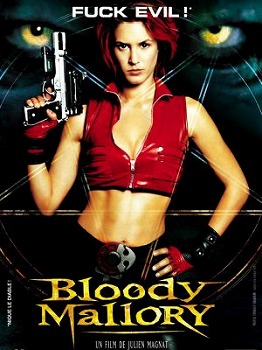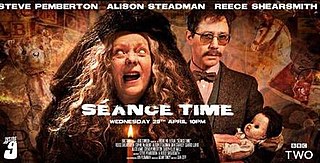"Nightmare as a Child" is episode 29 of the American television anthology series The Twilight Zone. It originally aired on April 29, 1960, on CBS.
"A World of His Own" is episode thirty-six of the American television anthology series The Twilight Zone. It was the last episode of the show's first season and essentially comedic in tone. It originally aired on July 1, 1960, on CBS.
"It's a Good Life" is the eighth episode of the third season of the American television series The Twilight Zone, and the 73rd overall. It was written by series creator/showrunner Rod Serling, based on the 1953 short story "It's a Good Life" by Jerome Bixby. The episode was directed by James Sheldon, and is considered by some, such as Time and TV Guide, to be one of the best episodes of the series. It originally aired on November 3, 1961. The episode was one of four from the original 1959 series which formed the basis of the 1983 film Twilight Zone: The Movie.

June Foray was an American voice actress and radio personality, best known as the voice of such animated characters as Rocky the Flying Squirrel, Natasha Fatale, Nell Fenwick, Lucifer from Disney's Cinderella, Cindy Lou Who, Jokey Smurf, Granny from the Warner Bros. cartoons directed by Friz Freleng, Grammi Gummi from Disney's Adventures of the Gummi Bears series, and Magica De Spell, among many others.
"Little Girl Lost" is episode 91 of the American television anthology series The Twilight Zone. It is about a young girl who has accidentally passed through an opening into another dimension. Her parents and their friend attempt to locate and retrieve her. It is based on the 1953 science fiction short story by Richard Matheson. The title of the episode comes from a poem by William Blake, from his collection Songs of Innocence and of Experience.

"Nightmare at 20,000 Feet" is the third episode of the fifth season American television anthology series The Twilight Zone, based on the short story of the same name by Richard Matheson, first published in the short story anthology Alone by Night (1961). It originally aired on October 11, 1963, and is one of the most well-known and frequently referenced episodes of the series. The story follows a passenger on an airline flight who notices a hideous creature trying to sabotage the aircraft during flight.
"Caesar and Me" is episode 148 of the American television anthology series The Twilight Zone starring Jackie Cooper as a ventriloquist. It is not to be confused with a similar episode "The Dummy", starring Cliff Robertson as a ventriloquist.
"The Bewitchin' Pool" is the 156th and last episode of the first incarnation of the American anthology television series The Twilight Zone. It originally aired on June 19, 1964 on CBS.

"Treehouse of Horror IV" is the fifth episode of the fifth season of the American animated television series The Simpsons and the fourth episode in the Treehouse of Horror series of Halloween specials. It originally aired on the Fox network in the United States on October 28, 1993, and features three short stories called "The Devil and Homer Simpson", "Terror at 5+1⁄2 Feet", and "Bart Simpson's Dracula".
"Treehouse of Horror II" is the seventh episode of the third season of the American animated television series The Simpsons. It first aired on the Fox network in the United States on October 31, 1991. It is the second annual Treehouse of Horror episode, consisting of three self-contained segments, told as dreams of Lisa, Bart and Homer and is the only Treehouse of Horror episode to date where each segment name is not stated inside the episode. In the first segment, which was inspired by W. W. Jacobs's short story The Monkey's Paw and The Twilight Zone episode "A Small Talent for War", Homer buys a Monkey's Paw that has the power to grant wishes, although all the wishes backfire. In the second part, which parodies the Twilight Zone episode "It's a Good Life", Bart is omnipotent, and turns Homer into a jack-in-the-box, resulting in the two spending more time together. In the final segment, Mr. Burns attempts to use Homer's brain to power a giant robotic laborer.
"Treehouse of Horror III" is the fifth episode of the fourth season of the American animated television series The Simpsons. It originally aired on the Fox network in the United States on October 29, 1992. The third annual Treehouse of Horror episode, it features segments in which Homer buys Bart an evil talking doll, Homer is a giant ape which is captured by Mr. Burns in a parody of the 1933 version of King Kong, and Bart and Lisa inadvertently cause zombies to attack Springfield.
Chatty Cathy was a pull-string "talking" doll originally created by Ruth and Elliot Handler and manufactured by the Mattel toy company from 1959 to 1965. The doll was first released in stores and appeared in television commercials beginning in 1960, with a suggested retail price of $18.00, though usually priced under $10.00 in catalog advertisements. Chatty Cathy was on the market for six years and was the second most popular doll of the 1960s after Barbie.

Bloody Mallory is a 2002 film directed by Julien Magnat at his directorial debut, and written by Magnat and Stéphane Kazandjian. The film stars Olivia Bonamy, Adrià Collado, Jeffrey Ribier, Laurent Spielvogel, Valentina Vargas, Julien Boisselier, and Thylda Barès. The film's score was composed by Kenji Kawai.

The Great Gabbo is a 1929 American Pre-Code early sound musical drama film directed by James Cruze, based on Ben Hecht's 1928 short story "The Rival Dummy", and starring Erich von Stroheim and Betty Compson. The film features songs by Lynn Cowan, Paul Titsworth, Donald McNamee and King Zany.

Slappy the Dummy is a fictional character and a major antagonist in the Goosebumps children's series by R. L. Stine. He is the main antagonist of the Night of the Living Dummy saga and one of the series' most popular villains, as well as its mascot. He is also the main antagonist of the franchise's film adaptation and its sequel, described by their interpretation of Stine as having a "serious Napoleonic complex" in the former. He comes alive when the words, "Karru Marri Odonna Loma Molonu Karrano," which roughly translates to "You and I are one now" and can be found on a sheet of paper in the coat pocket of Slappy's jacket, are read aloud. After being brought to life, Slappy will try to make the person who did so serve him as a slave, to the point of framing them for his evil deeds.

Annabelle is an allegedly-haunted Raggedy Ann doll, housed in the now closed occult museum of the paranormal investigators Ed and Lorraine Warren. Annabelle was moved there after supposed hauntings in 1970. A character based on the doll is one of the antagonists that appear in The Conjuring Universe.

"Séance Time" is the sixth and final episode of the second series of the British dark comedy anthology television programme Inside No. 9. It was first broadcast on 29 April 2015 on BBC Two. The episode was written by Steve Pemberton and Reece Shearsmith, and directed by Dan Zeff. It stars Pemberton, Shearsmith, Alison Steadman, Alice Lowe, Sophie McShera, Dan Starkey, Cariad Lloyd and Caden-Ellis Wall. The episode begins with Tina (McShera) arriving at a Victorian villa for a séance. Hives (Shearsmith) sits her at a table and then escorts the ominous, shrouded Madam Talbot (Steadman) into the room.

Mary LaRoche was an American actress and singer best known for her roles in the feature films Gidget (1959) and Bye Bye Birdie (1963) and for her performances as a guest star and supporting character on American television series between the early 1950s and mid-1970s, including on such popular series as The Twilight Zone, Alfred Hitchcock Presents, Perry Mason, and Gunsmoke.
Perigi's Wonderful Dolls is a 1955 science fiction short story written and adapted by George Lefferts for the radio drama series X Minus One. It was originally aired without commercials by NBC on June 5, 1955, and later rebroadcast on January 18, 1956. Comparisons have been raised between several aspects of this story and the Twilight Zone episode "Living Doll". However, having aired eight years before "Living Doll", "Perigi's Wonderful Dolls" is one of the first radio broadcasts to pioneer the killer toy horror genre.









